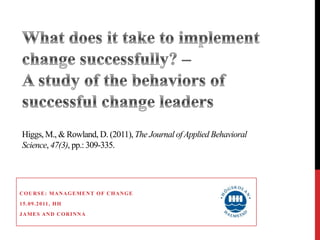
article summary of "What does it take to implement change successfully?"
- 1. Higgs, M., & Rowland, D. (2011), The Journal of Applied Behavioral Science, 47(3), pp.: 309-335. CO URS E : MANAGE ME NT O F CH ANGE 1 5 . 09 . 2 0 11 , HH JAME S AND CO RINNA
- 2. INTRODUCTION This article seeks to explore the impact of leaders’ behaviors on the successful implementation of change. Analyses of the data indicated that leader-centric behaviors have an adverse impact on change implementation. It was evident that leaders who experienced the highest levels of success deployed all four of the behavior sets and minimal presence of leader-centric behaviors 2
- 3. THEORY 1/2 • source: literature of leadership behavior + change leadership and their old model (2005) 3 main behavioral sets: shaping behavior (his/her communication & actions) framing change (starting points, communicating guiding principles) creating capacity (create capabilities, performance expectations) • new model (2011) 4 behavioral sets: a. attractor (goal-oriented energy force of pulling people through the change) b. edge and tension (disturbance to create the awareness to change) c. container (channeling energy to support and calm people) d. transforming space (instantly change of the present moment) 3
- 4. THEORY 2/2 • high success in change management: mix of different behavioral sets • linkages between the models: attractor + edge & tension + container = „framing“ (old) container + transforming space = „creating“ (old) attractor + edge & tension + container + transforming space = „framcap“ (combi of framing and creating) • different approaches to change: directive (top-down, no – little involvement, plan) self-assembly (top-down, little involvement: local managers) master (set in tmt, open dialogue & inputs of others, many actions) emergent (initiated everywhere, support of other firm members) 4
- 5. STUDY 1/2 -Research questions Research Question 1: Are leaders who exhibit behaviors that combine those of “Framing” and “Creating” more effective in implementing change than those who do not exhibit such behaviors? Research Question 2: Do leader-centric (Shaping) behaviors have a less negative impact on change success when combined with facilitating and engaging behaviors? -Informations of sample 1.Interviews sample that comprised 65 stories relating to change initiatives provided by leaders from 33 organizations.. 2. Each interview lasted for between 1 and 1.5 hours. The interviews were recorded and the recordings transcribed. 5
- 6. STUDY 2/2 A possible change leadership framework 1. Leaders need to focus efforts on doing change with people rather than doing change to them 2. The former approach and the associated behaviors provide a basis for more effective and successful change implementation 3. Leaders need to consider over and over again when the phenomenon within the context of organizational change 6